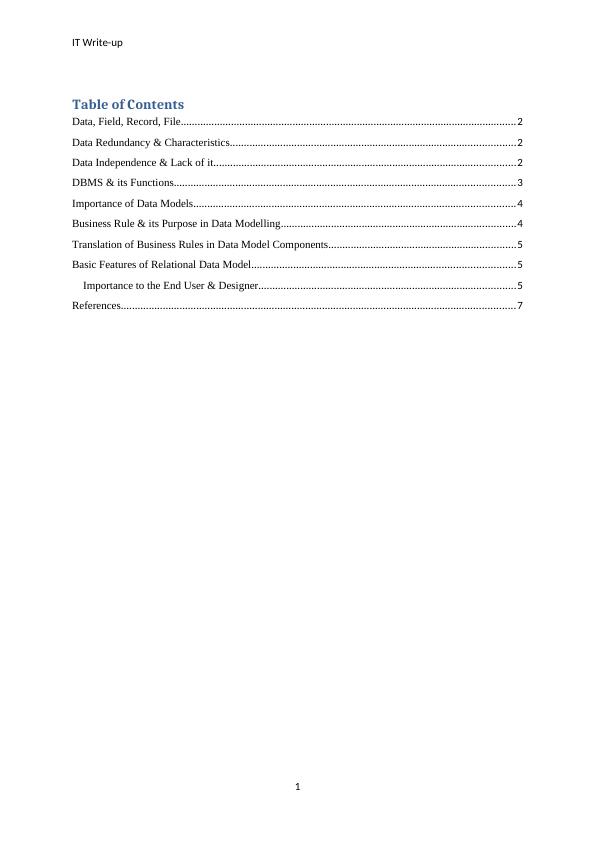IT Write-up: Data Models, DBMS Functions, Business Rules, and Relational Data Models
Added on 2023-04-23
8 Pages2015 Words125 Views
qwertyuiopasdfghjklzxcvbnmqw
ertyuiopasdfghjklzxcvbnmqwert
yuiopasdfghjklzxcvbnmqwertyui
opasdfghjklzxcvbnmqwertyuiop
asdfghjklzxcvbnmqwertyuiopasd
fghjklzxcvbnmqwertyuiopasdfgh
jklzxcvbnmqwertyuiopasdfghjkl
zxcvbnmqwertyuiopasdfghjklzxc
vbnmqwertyuiopasdfghjklzxcvb
nmqwertyuiopasdfghjklzxcvbnm
qwertyuiopasdfghjklzxcvbnmqw
ertyuiopasdfghjklzxcvbnmqwert
yuiopasdfghjklzxcvbnmqwertyui
opasdfghjklzxcvbnmqwertyuiop
asdfghjklzxcvbnmqwertyuiopasd
fghjklzxcvbnmqwertyuiopasdfgh
jklzxcvbnmrtyuiopasdfghjklzxcv
IT Write-up
1/19/2019
ertyuiopasdfghjklzxcvbnmqwert
yuiopasdfghjklzxcvbnmqwertyui
opasdfghjklzxcvbnmqwertyuiop
asdfghjklzxcvbnmqwertyuiopasd
fghjklzxcvbnmqwertyuiopasdfgh
jklzxcvbnmqwertyuiopasdfghjkl
zxcvbnmqwertyuiopasdfghjklzxc
vbnmqwertyuiopasdfghjklzxcvb
nmqwertyuiopasdfghjklzxcvbnm
qwertyuiopasdfghjklzxcvbnmqw
ertyuiopasdfghjklzxcvbnmqwert
yuiopasdfghjklzxcvbnmqwertyui
opasdfghjklzxcvbnmqwertyuiop
asdfghjklzxcvbnmqwertyuiopasd
fghjklzxcvbnmqwertyuiopasdfgh
jklzxcvbnmrtyuiopasdfghjklzxcv
IT Write-up
1/19/2019

IT Write-up
Table of Contents
Data, Field, Record, File........................................................................................................................2
Data Redundancy & Characteristics......................................................................................................2
Data Independence & Lack of it............................................................................................................2
DBMS & its Functions..........................................................................................................................3
Importance of Data Models...................................................................................................................4
Business Rule & its Purpose in Data Modelling....................................................................................4
Translation of Business Rules in Data Model Components...................................................................5
Basic Features of Relational Data Model..............................................................................................5
Importance to the End User & Designer............................................................................................5
References.............................................................................................................................................7
1
Table of Contents
Data, Field, Record, File........................................................................................................................2
Data Redundancy & Characteristics......................................................................................................2
Data Independence & Lack of it............................................................................................................2
DBMS & its Functions..........................................................................................................................3
Importance of Data Models...................................................................................................................4
Business Rule & its Purpose in Data Modelling....................................................................................4
Translation of Business Rules in Data Model Components...................................................................5
Basic Features of Relational Data Model..............................................................................................5
Importance to the End User & Designer............................................................................................5
References.............................................................................................................................................7
1

IT Write-up
Data, Field, Record, File
Data is defined as a set of values that is designed with respect to the qualitative and
quantitative variables.
A single piece of data or information is termed as a field. The collection of two or more fields
is termed as a record. A file is defined as a collection of two or more records. For instance, a
healthcare system comprises of healthcare data in which the fields may be the names of the
patients, contact details of the patients, professional information, medical code, etc. The
collection of all the fields associated with a single patient will form a record (Sul, Yeom &
Jung, 2018). The collection of more than two records of the same patient will form a patient
file.
Data Redundancy & Characteristics
Data redundancy is also referred as data duplication and it is a condition in which a particular
record is present in two or more separate locations. The duplication of the data sets may bring
up the integrity issues and may also enhance the irrelevance of the data sets (Tran & Oh,
2014).
The organizational structure of the file system is one of the characteristics that may contribute
towards data redundancy. For instance, the file system may organize the data sets in the form
of files, folders, directories, etc. A single file may be copied in more than one folder with the
same name. This may bring up the issue of data redundancy. The user may update the data
sets in one file present in a particular folder and may not update the information in the other
file. The integrity issues and information mismatch may come up as an occurrence.
Data Independence & Lack of it
Data independence refers to the property that states that the data that is generated and stored
must be kept independent and separate from the data that is used by the applications for the
purpose of presentation and computation. The ability to keep the data sets hidden from the
source code of the application is also termed as data independence. It is one of the properties
of the databases to make sure that the data properties are kept intact at all times (Pcmag,
2019).
2
Data, Field, Record, File
Data is defined as a set of values that is designed with respect to the qualitative and
quantitative variables.
A single piece of data or information is termed as a field. The collection of two or more fields
is termed as a record. A file is defined as a collection of two or more records. For instance, a
healthcare system comprises of healthcare data in which the fields may be the names of the
patients, contact details of the patients, professional information, medical code, etc. The
collection of all the fields associated with a single patient will form a record (Sul, Yeom &
Jung, 2018). The collection of more than two records of the same patient will form a patient
file.
Data Redundancy & Characteristics
Data redundancy is also referred as data duplication and it is a condition in which a particular
record is present in two or more separate locations. The duplication of the data sets may bring
up the integrity issues and may also enhance the irrelevance of the data sets (Tran & Oh,
2014).
The organizational structure of the file system is one of the characteristics that may contribute
towards data redundancy. For instance, the file system may organize the data sets in the form
of files, folders, directories, etc. A single file may be copied in more than one folder with the
same name. This may bring up the issue of data redundancy. The user may update the data
sets in one file present in a particular folder and may not update the information in the other
file. The integrity issues and information mismatch may come up as an occurrence.
Data Independence & Lack of it
Data independence refers to the property that states that the data that is generated and stored
must be kept independent and separate from the data that is used by the applications for the
purpose of presentation and computation. The ability to keep the data sets hidden from the
source code of the application is also termed as data independence. It is one of the properties
of the databases to make sure that the data properties are kept intact at all times (Pcmag,
2019).
2

End of preview
Want to access all the pages? Upload your documents or become a member.
Related Documents
My Health Record: Non-Functional Requirements, Cloud-based Solutions, and SDLC Approachlg...
|9
|2475
|252
Migration Plan for E-Business: Electronic Healthcare Applicationlg...
|14
|4224
|362
Quality Assurance Planlg...
|10
|1867
|219
